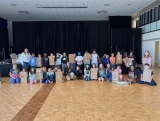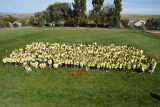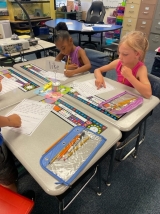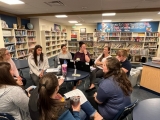-
Category 1
Selected in 2022
-
Grades: k - 5
School Setting: urban
Town Population: 483
Student Enrollment: 520
Student Demographics:
Black/African American: 0.7%
Teacher/Student Ratio: 1:22
White/Caucasian: 47%
Hispanic: 32%
Hawaiian/Pacific Islander: 0.1%
Asian: 0.8%
Native American: 0%
Other: 13%
% Reduced Lunch: 0%
% ELL Learners: 0%
Founded: 1972 -
PRINCIPAL:
Sarah Arellano -
CONTACT:
6910 Defoe Avenue
Colorado Springs, CO 80911
719-391-3455
arellanos@wsd3.org
Martin Luther King Jr. Elementary School
Colorado Springs, CO
"The culture shift occurred when we understood we had been working with collective efficacy."
- 1. Tell us about your school’s success.
-
The success that King Elementary has experienced has been incrementally built with years of hard work from the staff, students, and families. King has received 4 previous awards from the state celebrating the high levels of growth demonstrated by all levels of learners. There is exceptional focus on student outcomes, high levels of collaboration and ownership of our school community, as well as the belief that our students can achieve. Each staff member believes that our efforts make a difference in student achievement, therefore creating an atmosphere where collective efficacy reigned. If and when students weren’t growing academically we asked the question - What can WE do differently? The administration is committed to monitoring and providing feedback on the collective goals set yearly. It is encouraging to know that not even a pandemic can falter our belief that students can and will succeed
- 2. Talk about the greatest contributing factor(s) that promoted positive change in your school.
-
There are so many contributing factors contributing to the success of King Elementary. Our collective decisions supported a focus on multi-tiered systems of support. We addressed students' needs by adjusting our master schedule, creating a strong PBIS system, and realizing that continuous adjustments will need to be made based on student data. An additional 30 minutes was built into the schedule to promote learning growth for all levels of learners to include our IEP students as well as our Gifted learners. Students broke out into small groups of targeted support and or enrichment.
High levels of collaboration are one of the most significant factors for our success. We are committed to weekly collaboration meetings with a focused approach to planning for student outcomes, formative checks, and engagement throughout lessons. Teachers' expertise is shared during these meetings along with healthy discourse that promotes the best approaches to each lesson.
- 3. How has ESEA funding supported the school's success?
-
ESEA funds have supported our growth and sustainability in student achievement in multiple ways. These funds allowed us as principals to make decisions based on student and teacher needs. Students are given additional, outside the classroom, intervention support through Title One teachers. The extra support allowed us to target specific student needs and continue to progress them on an outlined continuum of skills. Students are provided with tutoring sessions focused on intervention in literacy and math. We are able to keep up student learning over the summer as well, through summer school support with ESEA funds. Funds allow our students to engage in field experiences such as STEM activities and attend field trips directly aligned with our PBL model that allow students to engage in learning that cultivates curiosity and maximizes learning within our local community.
- 4. What professional development activities were used to improve teaching and learning?
-
The staff at King Elementary have participated in multiple PD sessions. Over the years, we have spent a significant amount of time focused on our school district’s Research-Based Teaching and Learning Cycle. Every year, we chose as a school what portions will be most appropriate to focus on. The process of this is very organic and brought about through observations, data, and teacher input of their specific needs. The one item that has never left the agenda is collaboration. As we began our journey into our PBL innovation, staff dedicated time to developing their knowledge of the PBL Gold Standard of Teaching Practices and Essential Design Elements. We have had outside companies provide PD as well as in-house PD where admin and teachers were the PD providers. Some of the most powerful PD sessions are those where teachers teach teachers, collaboration to share best practices occurs, and vertical alignment is a focus.
- 5. Talk about the cultural shift leading up to your school's success.
- The culture shift occurred when we understood we had been working with collective efficacy. Administration empowered teachers to take steps forward, believe in their abilities, rely on each other's knowledge, and plan for all students in the classroom. As success began to occur, teacher efficacy developed. As we each believed in ourselves, we began to believe we can make a difference. It’s amazing what small bits of success can do for a teacher. Our collective decisions supported a focus on systems of support. This in turn transcended into student efficacy. Our students model a growth mindset approach, truly believing that they can and will meet the high expectations we set as a community. Through the process of goal setting and self-reflection, our students demonstrate a commitment to owning their learning and success.
- 6. How has community involvement strengthened your success?
- King Elementary’s community is as committed to student success as the staff. The investment of our families, neighbors, and local partnerships promotes our value of collective efficay. Our families demonstrate a strong commitment to student excellence, working alongside our educators in growing student's academic and social-emotional capacity. We have a strong model of programs and incentives that promote family engagement centered on best practices to address student learning. Members within our community join our classrooms, providing expertise and promoting real-life connections. These partnerships provide students with authentic audience members where students can engage in the cycle of feedback, reflect, and revise with an adult beyond their teacher. Because our students are exposed to an array of real-life experts, they develop interests that promote choice in their future. Our students know that our community is invested in them and they in turn are invested in themselves.
Stats
-
Category 1
Selected in 2022
-
Grades: k - 5
School Setting: urban
Town Population: 483
Student Enrollment: 520
Student Demographics:
Black/African American: 0.7%
Teacher/Student Ratio: 1:22
White/Caucasian: 47%
Hispanic: 32%
Hawaiian/Pacific Islander: 0.1%
Asian: 0.8%
Native American: 0%
Other: 13%
% Reduced Lunch: 0%
% ELL Learners: 0%
Founded: 1972 -
PRINCIPAL:
Sarah Arellano -
CONTACT:
6910 Defoe Avenue
Colorado Springs, CO 80911
719-391-3455
arellanos@wsd3.org






